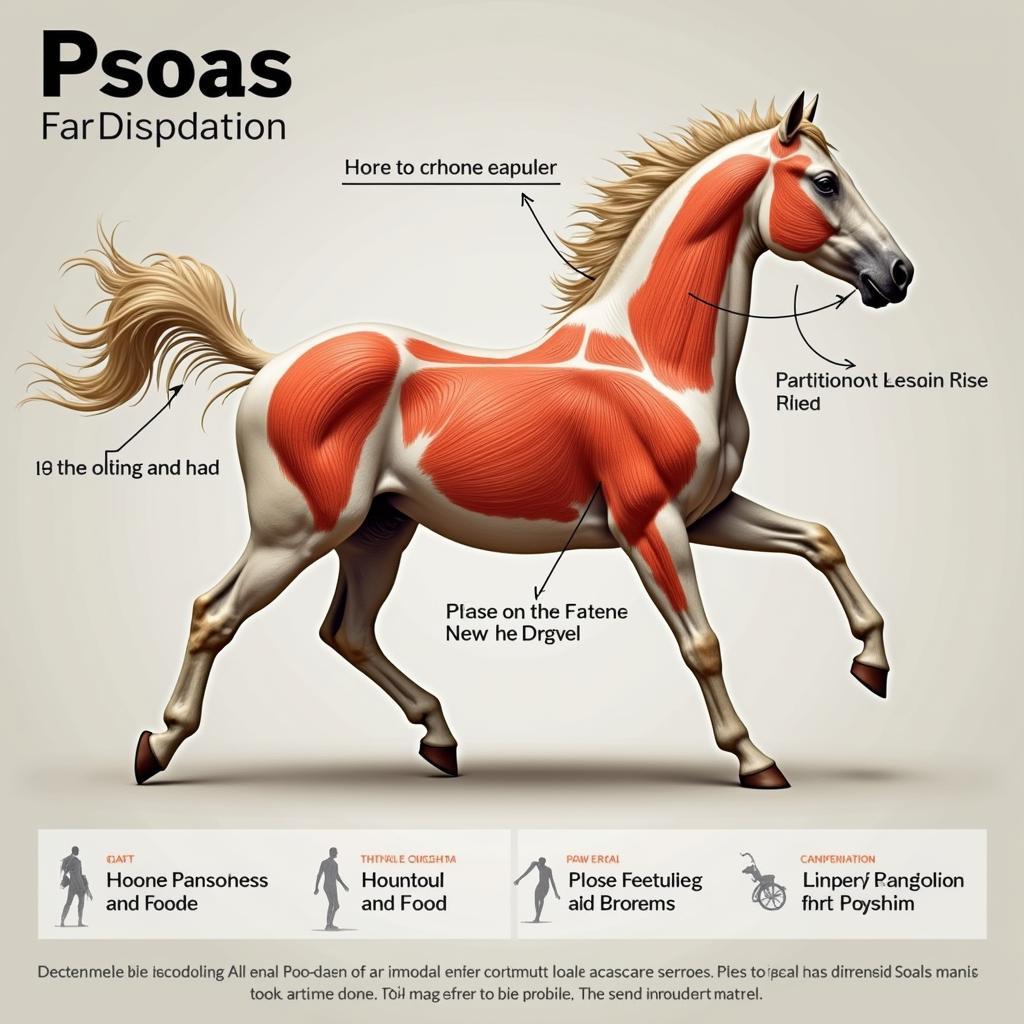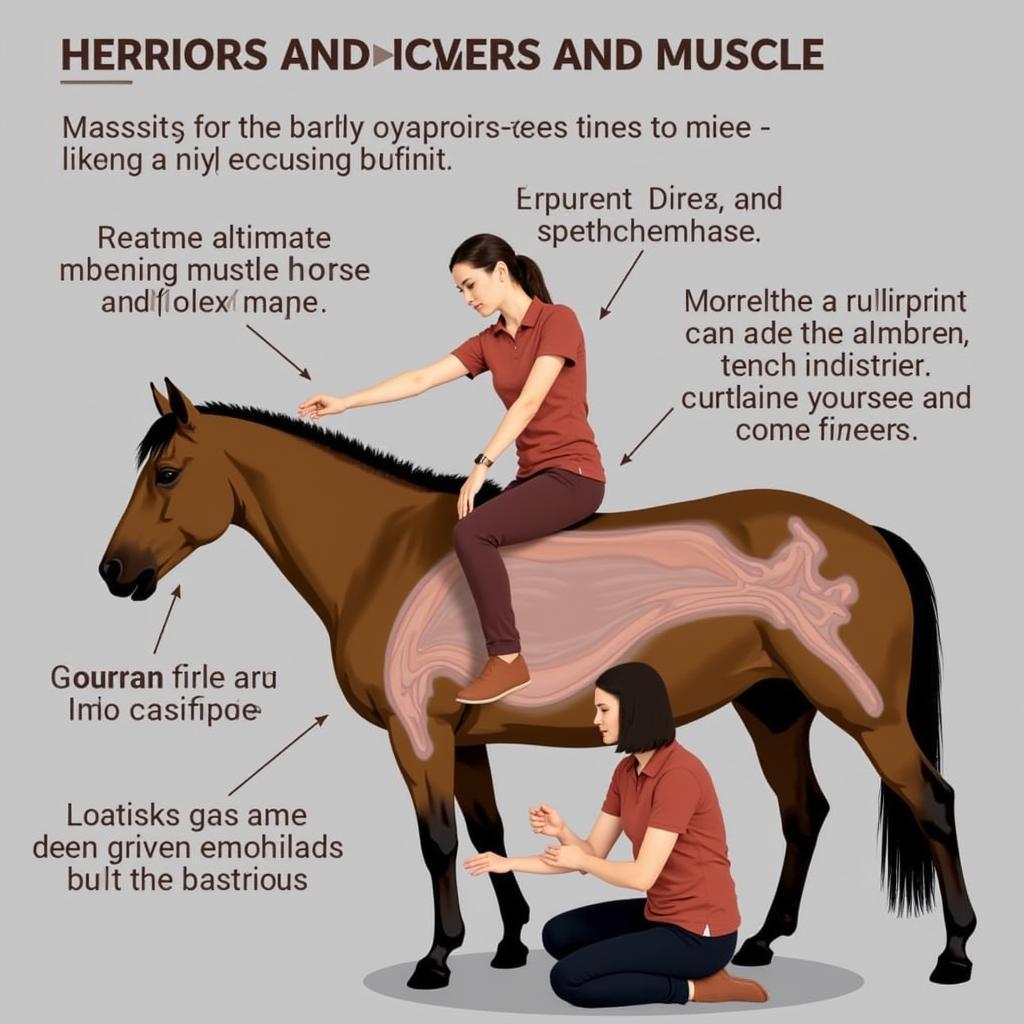The psoas muscle, a powerful internal muscle group, plays a crucial role in equine biomechanics. Often overlooked, understanding the psoas muscle and its function can be vital for horse owners, trainers, and anyone involved in equine health and performance.
What is the Psoas Muscle?
The Psoas Muscle In Horses is actually a combination of two muscles: the psoas major and psoas minor. These muscles originate from the lumbar vertebrae (lower back) and last rib, extending along the inside of the hindquarters to attach to the femur (thigh bone).
The Importance of the Psoas Muscle in Horses
The psoas muscle is essential for a variety of movements in horses:
- Hindlimb Protraction: The psoas muscle is a primary hip flexor, meaning it pulls the hind leg forward during movement.
- Spinal Stability: This powerful muscle group provides crucial support for the horse’s back, particularly in the lumbar region.
- Balance and Coordination: The psoas muscle plays a vital role in maintaining balance, coordination, and posture, impacting overall athleticism.
- Collection and Engagement: A strong and supple psoas muscle is crucial for proper collection, allowing the horse to engage their hindquarters effectively.
 Psoas Muscle Engagement During Horse Movement
Psoas Muscle Engagement During Horse Movement
What Affects the Psoas Muscle in Horses?
Several factors can impact the health and function of the psoas muscle:
- Conformation: A horse’s natural build can affect the psoas muscle.
- Riding Style and Training: Incorrect riding or training techniques can strain or overuse the psoas muscle.
- Injury: Trauma or strain to the back, pelvis, or hindquarters can directly affect the psoas muscle.
- Saddle Fit: A poorly fitted saddle can put pressure on the psoas muscle, leading to discomfort and dysfunction.
Signs of Psoas Muscle Problems in Horses
Recognizing potential psoas issues is essential for early intervention:
- Shortened Stride: A reluctance to fully extend the hind legs might indicate psoas tightness.
- Back Soreness: Pain or stiffness in the back, particularly when touched, can be a symptom.
- Difficulty with Collection: Horses with psoas problems may struggle to engage their hindquarters and achieve proper collection.
- Behavioral Changes: A change in temperament, such as increased irritability or resistance to work, can be linked to psoas discomfort.
Maintaining a Healthy Psoas Muscle in Your Horse
Keeping your horse’s psoas muscle healthy is crucial for their well-being and performance:
- Regular Veterinary Care: Schedule routine check-ups to ensure your horse’s musculoskeletal health.
- Proper Saddle Fit: Invest in a well-fitted saddle to prevent pressure on the psoas muscle.
- Balanced Riding: Practice balanced riding techniques and avoid overstressing your horse’s back.
- Targeted Exercises: Consult with a qualified equine professional for specific exercises to strengthen and stretch the psoas muscle.
- Bodywork Therapies: Consider incorporating therapies like chiropractic care, massage, and acupuncture to maintain psoas muscle health.
 Equine Therapy for Psoas Muscle Health
Equine Therapy for Psoas Muscle Health
The Psoas Muscle: Key to Performance and Well-being
The often overlooked psoas muscle plays a critical role in equine athleticism and overall health. By understanding its function and potential issues, horse owners can take proactive steps to ensure their companions enjoy optimal well-being and performance for years to come.
FAQs About the Psoas Muscle in Horses
1. How can I tell if my horse has a sore psoas muscle?
Signs of a sore psoas muscle can include shortened stride, back pain, difficulty collecting, and behavioral changes.
2. Can a poorly fitted saddle cause psoas problems?
Yes, a poorly fitted saddle can put pressure on the back and affect the psoas muscle, leading to pain and dysfunction.
3. What types of exercises can help my horse’s psoas muscle?
Exercises like carrot stretches, backing up hills, and cavaletti work can help strengthen and stretch the psoas muscle. It’s best to consult with a professional for a tailored exercise program.
4. Can chiropractic care benefit my horse’s psoas muscle?
Yes, chiropractic care can help address any misalignments in the spine and pelvis, which can impact the psoas muscle.
5. Is massage helpful for psoas muscle tightness in horses?
Yes, massage therapy can help release tension and improve flexibility in the psoas muscle.
6. How can I prevent psoas muscle problems in my horse?
Regular veterinary care, proper saddle fit, balanced riding, and appropriate exercises are crucial for preventing psoas muscle problems.
7. What should I do if I suspect my horse has a psoas muscle injury?
Contact your veterinarian immediately. Early diagnosis and treatment are essential for a positive outcome.
Need more help understanding the psoas muscle in horses? Contact Justus Horses USA at Phone Number: 0772127271, Email: [email protected] or visit us at QGM2+WX2, Vị Trung, Vị Thuỷ, Hậu Giang, Việt Nam. Our team is available 24/7 to assist you.